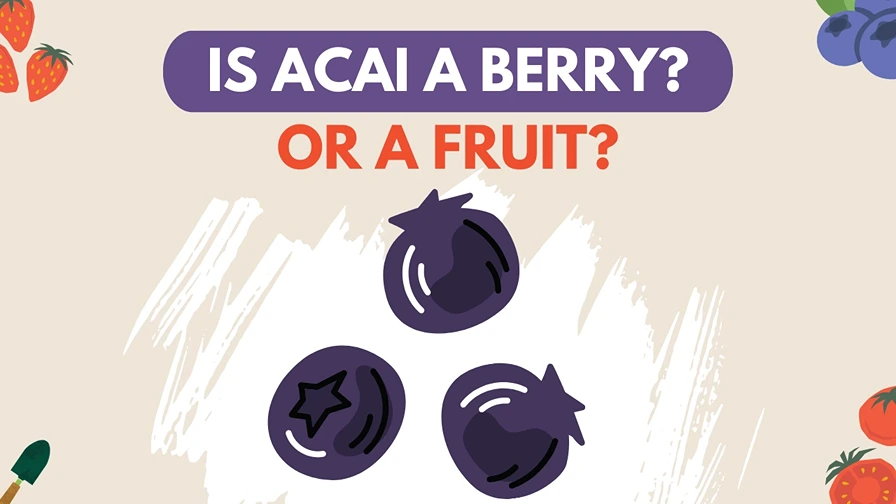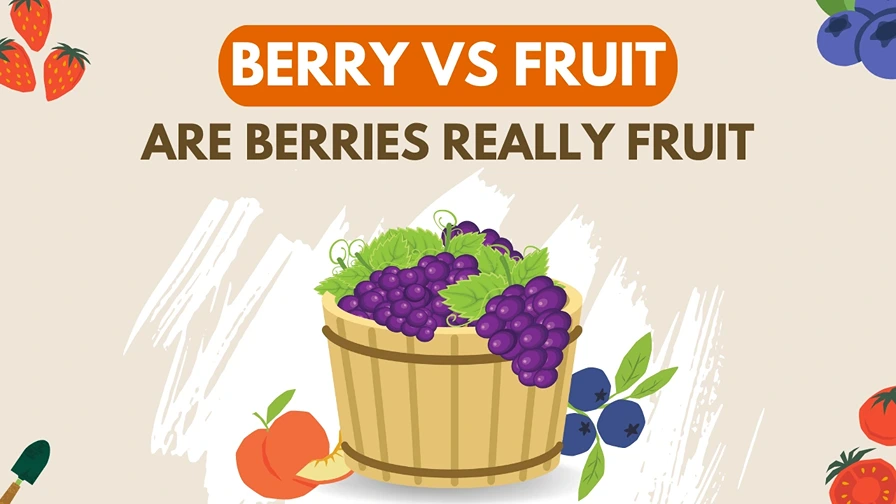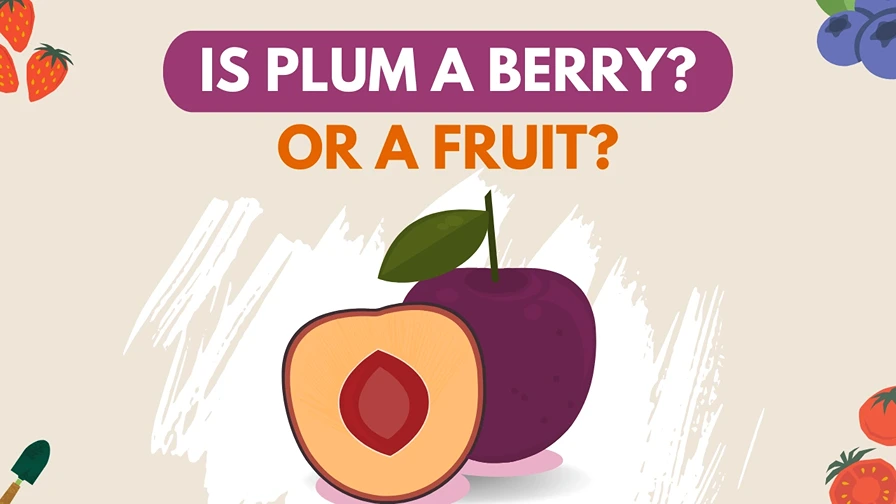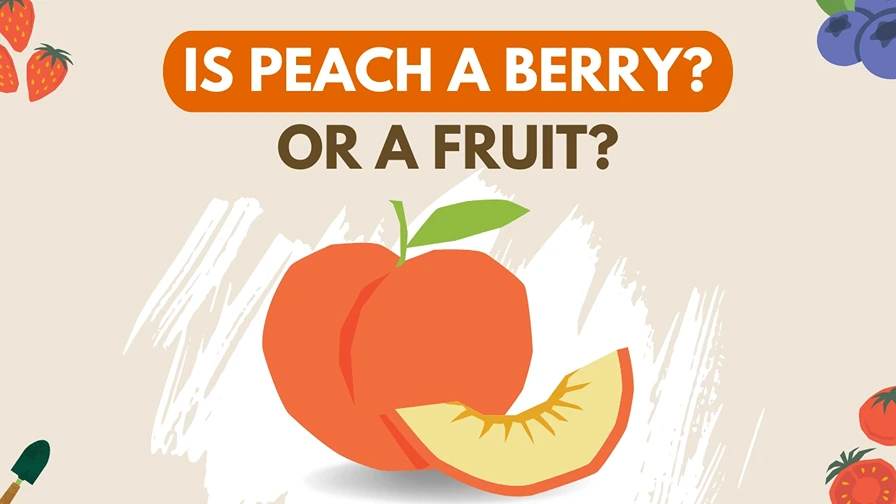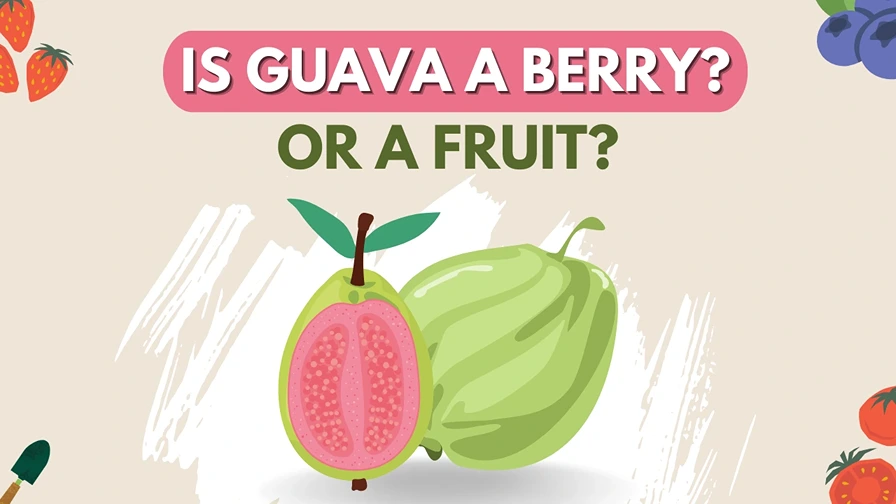Acai, the small purple fruit, has gained significant popularity in recent years due to its numerous health benefits and exotic appeal. However, there seems to be a lingering question among many curious minds: Is acai a berry or a fruit?
This seemingly simple query has sparked debates and confusion over the years. And sometimes it’s important to gain and acknowledge such basic information.
To answer the confusion: Acai is a fruit, specifically a drupe.
But why Acai is a drupe? And why it is not considered a berry.
By the end of this article, you will have a comprehensive understanding of why acai should be considered a fruit and not a berry.
So, without further ado, let’s dive into the fascinating world of acai and uncover the truth behind this captivating berry vs fruit debate.
What is Acai?
Acai (Euterpe oleracea) is a small, dark purple fruit that grows on the acai palm tree, scientifically known as Euterpe oleracea. This palm tree is native to the lush rainforests of the Amazon basin in South America, primarily found in Brazil.
The acai fruit is roughly the size of a grape, with a deep purple color and glossy outer skin. It is renowned for its rich antioxidant properties, making it a sought-after superfood in many parts of the world.
Botanical Description of Acai
The acai palm tree (Euterpe oleracea) is a slender, tall tree that typically reaches heights of 15 to 30 meters (49 to 98 feet). It thrives in the tropical rainforests of the Amazon basin, particularly in Brazil.
The fruit contains a large seed, which takes up most of its interior, while the pulp surrounding the seed is the edible part.
Leaves and Growth Habit
The leaves of the acai palm are pinnate, meaning they are arranged in a feather-like manner along a central stalk. Each leaf consists of numerous leaflets, typically numbering between 4 and 8 pairs.
These leaflets are long, narrow, and have a pointed tip. The overall appearance of the leaves gives the acai palm an elegant and distinctive look.
Acai palm trees grow in clumps or clusters, forming dense groups called “stands.” These stands can contain dozens of individual trees, creating a lush and visually striking presence in the rainforest.
Flowers and Fruits
The acai palm tree produces small flowers that are arranged in clusters known as inflorescences. These inflorescences are pendulous and emerge from among the leaves of the tree.
The flowers themselves are tiny and pale yellow or green in color. Following successful pollination, the acai palm produces fruits, which are the highly sought-after acai berries.
The fruits are small and round, measuring approximately 1 to 2 centimeters (0.4 to 0.8 inches) in diameter. They grow in dense clusters, often numbering in the hundreds on a single palm tree.
Acai’s Nutritional Benefits
Acai is celebrated for its exceptional nutritional profile. It is packed with essential vitamins, minerals, and beneficial plant compounds that contribute to its reputation as a balanced food.
Acai berries are notably rich in antioxidants, particularly anthocyanins, which are responsible for the fruit’s vibrant purple hue. These antioxidants help protect the body against harmful free radicals and oxidative stress.
In addition to antioxidants, fiber, and healthy fats, acai berries provide an array of essential nutrients, including vitamin A, vitamin C, and vitamin E, and minerals such as potassium, calcium, and magnesium.
This impressive nutritional composition makes acai a valuable addition to a well-balanced diet.
Intake Recommendation:
Acai berries are generally safe for most people when consumed in moderation as part of a varied diet. You can incorporate acai into your diet based on your taste preferences and overall dietary goals. Here are a few suggestions:
1. Occasional consumption: If you enjoy acai as a treat or an occasional addition to your meals, you can include it whenever you desire, perhaps once or twice a week.
2. Regular intake: Some individuals may choose to include acai berries in their regular diet due to their nutritional benefits. In this case, you can consume acai more frequently, such as a few times per week.
3. As part of a balanced diet: Acai berries are just one component of a healthy diet. It is important to consume a variety of fruits, vegetables, whole grains, lean proteins, and healthy fats to obtain a wide range of nutrients. Acai can be a part of your overall balanced diet and should not be relied upon as the sole source of nutrition.
Remember that the key to a healthy diet is variety, so don’t solely focus on acai berries. Incorporate a diverse range of fruits, vegetables, and other nutritious foods into your meals for optimal health benefits.
Culinary Uses and Popular Consumption
Traditionally, the indigenous tribes of the Amazon rainforest have been incorporating acai berries into their diets for centuries. They would often prepare a thick, purple acai paste by mashing the fruit and combining it with other ingredients.
In recent years, acai has gained global popularity as a versatile ingredient in various culinary creations. It is commonly used to make acai bowls, smoothies, juices, and even desserts.
The vibrant color, unique flavor, and nutritional benefits of acai have made it a favorite among health-conscious individuals worldwide.
In summary, acai is a small purple fruit that grows on the acai palm tree in the Amazon rainforest. It possesses a rich nutritional profile, abundant in antioxidants, fiber, and essential nutrients. The fruit’s versatile culinary applications have made it a beloved ingredient in many dishes and beverages.
Acai Berry: A True Fruit or a Berry?
By now, you are familiar with Acai. So, returning to our question: Is the acai a true fruit or a berry? To answer this, we need to examine the botanical definitions of how to categorize fruits and berries.
Botanical Definition of Fruits
- Botanically speaking, a fruit is the mature ovary of a flowering plant. It develops after successful fertilization and contains seeds.
- Fruits serve as a means of protecting and dispersing seeds, aiding in the reproductive process of plants.
- Common examples of fruits include apples, oranges, and peaches.
Botanical Definition of Berries
- A berry, on the other hand, is a specific type of fruit that develops from a single ovary, typically with a fleshy pericarp (the part of the fruit derived from the ovary wall).
- Berries are usually small and have a soft, edible pericarp.
- Botanical berries include grapes, tomatoes, and blueberries.
Acai Berry: Berry or Drupe
When it comes to the acai berry, it is technically classified as a drupe, which is a specific type of fruit. A drupe is a fleshy fruit that consists of:
- an outer skin (exocarp),
- a pulpy middle layer (mesocarp), and
- a hard inner shell (endocarp) that surrounds the seed.
The acai berry exhibits characteristics of a drupe-like fruit. It has a thin outer skin, a juicy pulp, and a large seed at its core. The edible part of the acai berry is the pulp, which is rich in nutrients and prized for its health benefits.
In botanical terms, the acai berry is classified as a drupe fruit, due to its specific structure comprising an outer skin, pulpy layer, and inner seed. While not a true berry in the botanical sense, it shares similarities with berries due to its small size, fleshy pulp, and widespread culinary use.
Why Acai is Classified as a Drupe?
The classification of acai as a drupe is based on its structural characteristics and botanical classification. Let’s explore in detail why acai falls under the category of a drupe.
1. Outer Skin (Exocarp): The acai berry has a thin outer skin or exocarp, which is a distinguishing feature of drupes. This protective layer covers the fruit, shielding it from external elements and potential damage.
2. Pulpy Middle Layer (Mesocarp): Beneath the outer skin lies the pulpy middle layer, known as the mesocarp. This fleshy portion of the fruit is rich in nutrients, antioxidants, and flavors. The mesocarp of acai berries is what makes them highly desirable and sought after in various culinary preparations.
3. Hard Inner Shell (Endocarp): One of the defining characteristics of drupes is the presence of a hard inner shell, called the endocarp, surrounding the seed. In the case of acai, this inner shell protects the large seed found at the core of the fruit.
4. Single Seed: Drupe classification also entails the presence of a single seed within the fruit. Acai berries adhere to this criterion as they contain a large, solitary seed at their center.
5. Culinary and Botanical Consensus: Experts in the field of botany and culinary science have reached a consensus on the classification of acai as a drupe. Through extensive research and examination of its anatomical structure, acai’s characteristics align with the key attributes of drupes.
6. Examples of Other Drupes: Acai’s classification as a drupe becomes clearer when we consider other fruits in this category. Common examples of drupes include peaches, cherries, plums, and olives. Acai berries share similarities with these fruits in terms of their structural composition.
Considering the outer skin, pulpy middle layer, hard inner shell, presence of a single seed, and the consensus among experts, it is evident that acai fits the classification of a drupe.
While it may not fit the botanical definition of a true berry, acai’s characteristics and structural composition align with those of drupes.
Why Acai is Not Classified as a Berry?
Although acai berries share some similarities with berries in terms of their size and culinary uses, they do not fit the botanical definition of a true berry. Let’s explore the reasons why acai is not classified as a berry:
1. Ovary Structure: Botanically, a true berry develops from a single ovary with multiple seeds embedded in the fleshy pericarp. In contrast, the acai berry develops from a single ovary but contains only one large seed. This structural difference sets it apart from botanical berries.
2. Lack of Soft Pericarp: Berries typically have a soft, fleshy pericarp that is edible and contributes to their characteristic taste and texture. However, the acai berry’s pericarp is not soft. Instead, it consists of a thin outer skin and a fibrous mesocarp, which is not as tender or pulpy as that of traditional berries.
3. Size and Texture: True berries, such as blueberries and raspberries, tend to be small, round, and have a delicate texture. Acai berries, on the other hand, are slightly larger, measuring around 1 to 2 centimeters (0.4 to 0.8 inches) in diameter. They have tougher skin and a denser pulp, making them distinct from botanical berries.
4. Botanical Classification Consensus: Botanical experts and taxonomists have collectively determined that acai does not meet the specific criteria required to be classified as a true berry. The consensus among scientific communities supports its classification as a drupe rather than a berry.
5. Distinctive Characteristics: While berries are known for their sweet or tart flavors, acai berries possess a unique taste profile with notes of earthiness and subtle bitterness. This distinctive flavor profile further distinguishes them from traditional botanical berries.
Although acai berries share certain visual and culinary similarities with botanical berries, they do not align with the botanical definition of a true berry. The absence of a soft pericarp, the presence of a single large seed, and the structural differences set acai apart from the characteristics of botanical berries.
The consensus among experts supports its classification as a drupe rather than a berry.
Common Fruits That Are Berries
1. Tomato (Solanum lycopersicum): Botanically speaking, tomatoes are classified as berries. They meet the criteria of a true botanical berry, as they develop from a single ovary and contain seeds. However, in culinary terms, tomatoes are commonly referred to as vegetables due to their savory flavor and culinary usage in savory dishes.
2. Avocado (Persea Americana): Surprisingly, avocados are also considered botanical berries. They possess a fleshy pericarp and a single large seed, characteristics that align with the botanical definition of berries. However, avocados are typically referred to as a type of fruit due to their culinary usage and creamy texture.
3. Cucumber (Cucumis sativus): Cucumbers, often enjoyed in salads and refreshing beverages, are classified as botanical berries. They develop from a single ovary and contain numerous small seeds. Despite their botanical classification as berries, cucumbers are commonly known and consumed as vegetables.
4. Eggplant (Solanum melongena): Eggplants, with their smooth, glossy skin and versatile culinary applications, are another example of fruits classified as botanical berries. They develop from a single ovary and contain numerous small seeds. However, they are typically referred to and prepared as a vegetable in various cuisines worldwide.
5. Kiwifruit (Actinidia deliciosa): Kiwifruit, with its vibrant green flesh and unique flavor, is botanically classified as a berry. It meets the criteria of a true botanical berry, as it develops from a single ovary and contains numerous small seeds. Despite its botanical classification, kiwifruit is often known simply as “kiwi” and is recognized as a distinct type of fruit.
Conclusion
While acai berries possess certain similarities with botanical berries, such as their small size and culinary uses, they do not fit the precise botanical definition of a true berry.
While the term “berry” can be used to describe various fruits, acai is commonly referred to as an “acai berry” due to its size, shape, and not an actual botanical classification.
Instead, acai is classified as a drupe due to its structural composition, which includes an outer skin, a pulpy mesocarp, a hard endocarp, and a single large seed. This classification aligns it with other fruits like peaches, cherries, and plums, which share similar structural characteristics.
Despite not being a true botanical berry, acai’s drupe classification does not diminish its remarkable nutritional profile, antioxidant properties, and culinary versatility.
So next time before eating those nutritional delights, remember that acai is a drupe.

